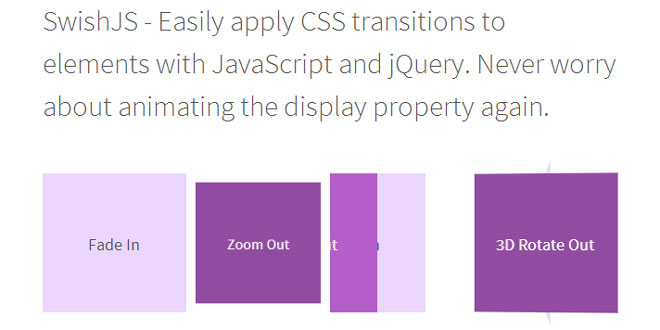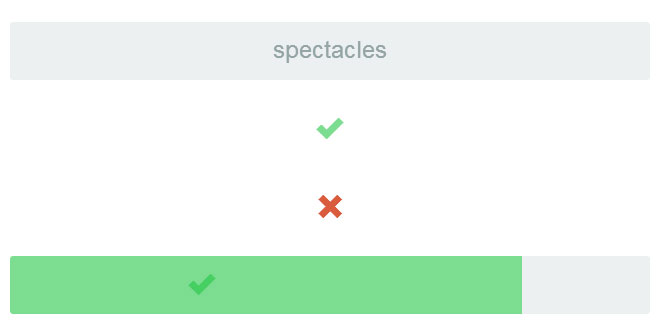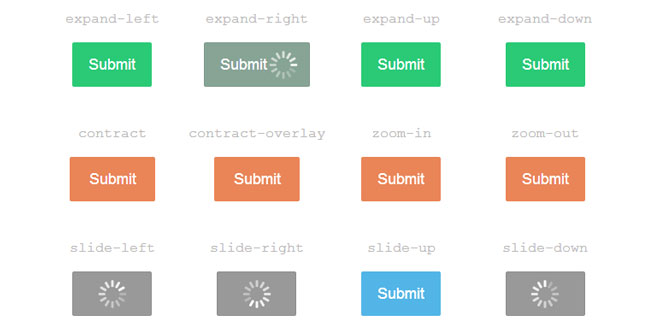- Overview
- Documents
SwishJS is a lightweight JavaScript library for animating elements using pre-defined CSS transitions. Includes jQuery plugin.
Source: jordanranson.github.io
1. INCLUDE CSS AND JS FILES
<link rel="stylesheet" type="text/css" href="../dist/css-swish-transitions.css"> <script src="//cdnjs.cloudflare.com/ajax/libs/jquery/2.1.1/jquery.js"></script> <script src="../dist/jquery.css-swish.js"></script>
2. HTML
<div class="demo-section"> <div class="x-demo-1-a hidden" data-swish-transition="swish-fade"> <span>Fade In</span> </div> <div class="x-demo-1-b" data-swish-transition="swish-fade"> <span>Fade Out</span> </div> </div> <div class="demo-section"> <div class="x-demo-2-a hidden" data-swish-transition="swish-zoom"> <span>Zoom In</span> </div> <div class="x-demo-2-b" data-swish-transition="swish-zoom"> <span>Zoom Out</span> </div> </div> <div class="demo-section" style="overflow:hidden"> <div class="x-demo-3-a hidden" data-swish-transition="swish-slide"> <span>Slide In</span> </div> <div class="x-demo-3-b" data-swish-transition="swish-slide"> <span>Slide Out</span> </div> </div> <div class="demo-section"> <div class="x-demo-4-a hidden" data-swish-transition="swish-3d-rotate"> <span>3D Rotate In</span> </div> <div class="x-demo-4-b" data-swish-transition="swish-3d-rotate"> <span>3D Rotate Out</span> </div> </div>
3. JAVASCRIPT
$(function() {
$('.demo-section div').click(function() {
var $tar = $(this);
$tar.swish();
$tar.siblings('div').swish();
});
});
Native JS
var elem = document.querySelector('#selector');
elem.swish('swish-fade', 1000);
4. ADVANCED
Data Attributes
The easiest way to use Swish is to add data attributes to your markup. Set the transition class using data‑swish‑transition and the duration withdata‑swish‑duration. The duration attribute is optional and will default to the rules in your stylesheet.
HTML
<div
id="selector"
data-swish-transition="swish-fade"
data-swish-duration="500"
></div>
NATIVE JS
var elem = document.querySelector('#selector');
elem.swish();
JQUERY
$('#selector').swish();
More Methods
You can also transition in a specific direction using swishIn and swishOut. These methods take the same arguments as swish.
NATIVE JS
elem.swishIn(transition, duration); elem.swishOut(transition, duration);
JQUERY
$('#selector').swishIn(transition, duration);
$('#selector').swishOut(transition, duration);
Default State
If the default state of your element is hidden, you will need to adddisplay: none to that element. This lets Swish know that the element isn't visible.
Custom Transitions
Swish wouldn't be very useful if you couldn't supply your own transitions, and it lets you do just that! You just need a main transition class and an in and outstate. The in state is applied when the element is visible, and the out state when hidden.
CSS
.example-transition {
transition: all 1s ease-in-out;
}
.example-transition.out {
background: blue;
}
.example-transition.in {
background: red;
}
NATIVE JS
var elem = document.querySelector('#selector');
elem.swish('example-transition');
JQUERY
$('#selector').swish('example-transition');
Return Value
Swish returns the duration of the animation in ms when called. This can be useful if you need to queue animations. Because jQuery methods are all monads, the jQuery plugin does not have this behaviour by default and requires additional parameters to be supplied.
NATIVE JS
var duration = elem.swish();
// duration = 1000, the default as specified in CSS
var duration = elem.swish('example-transition');
// duration = 1000, the default as specified in CSS
var duration = elem.swish('example-transition', 5000);
// duration = 5000, the value provided to the method
JQUERY
var duration = $('#selector').swish(true);
// duration = 1000, the default as specified in CSS
var duration = $('#selector').swish('example-transition', true);
// duration = 1000, the default as specified in CSS
var duration = $('#selector').swish('example-transition', 5000, true);
// duration = 5000, the value provided to the method
Configuration
By default Swish uses the classes in and out to show and hide elements. If this doesn't work with your project, you can configure Swish to use other classes.
NATIVE JS
Swish({
hiddenClass: 'out',
visibleClass: 'in'
});
JQUERY
$.Swish({
hiddenClass: 'out',
visibleClass: 'in'
});
 JS Tutorial
JS Tutorial




